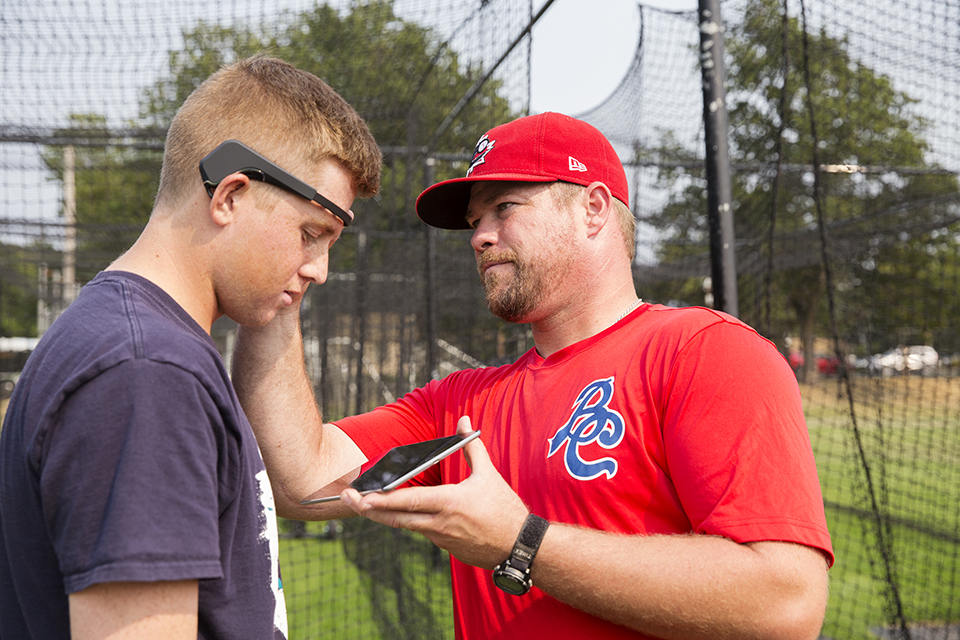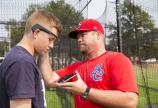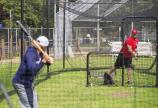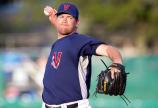Can brainwaves predict baseball performance?
- Suzanne Ahearne

Many consider baseball to be one of the most difficult skills in any sport. So, what makes a batter successful? Some think it requires that the athlete be in “the zone”—a mental state in which performance is optimal. But what is “the zone”? Can it be quantified?
Olav Krigolson, UVic neuroscientist, paired up with Anthony Pluta, a pro-ball-player-turned-grad-student to find out.
Working with portable brainwave technology out of Krigolson’s Neuroeconomics Lab at UVic, Pluta—who pitched for Major League Baseball affiliate organizations in Canada, Japan and the US for 13 years—recorded brain wave data from 60 baseball players for a few minutes prior to batting practice. For this, they used a headband-sized electroencephalographic (EEG) device, a consumer product called the Muse, its software unlocked and modified by the lab for research purposes.
After two minutes of testing immediately prior to batting practice, players had their batting performance and their performance was rated by three certified coaches in terms of pitch recognition, form, power and contact with the ball.
When a baseball player walks up to bat, their brainwaves can predict performance, according to a new @uvic study https://t.co/UvSrr71etU pic.twitter.com/DQwMCL3OGT
— CBC British Columbia (@cbcnewsbc) August 2, 2017
When Krigolson and Pluta analyzed the data, they were surprised to find that the higher the batter’s brain activity in the beta range (16-30 Hz) — a range typically associated with increased cognition and concentration — the worse they performed during batting practice. Players with lower activity in the beta range hit better during batting practice, a range associated with a more relaxed state.
"It's in line with the anecdotal stuff you always hear coaches say, 'don't over-think it, just play, calm down,'" says Krigolson.
Importantly, by using EEG technology prior to batting, their results suggest that measuring brain activity is a more reliable indicator of performance than more indirect or observational interpretations.
“As a retired professional, the best days I had were the days where I wasn’t thinking. Or not thinking about the task at hand,” Pluta says. “Initially, I just wanted to quantity what was ‘the zone.’ Now that we have a quantifiable number that will describe the zone, the next thing is being able to do more research. If we’re able to track players over a year, we’ll be able to know specifically in what beta frequency they perform their best. Then, we want to work with a team of people to develop a way to help them put into a better brain frequency…get them to think less and just react.”
The next steps for this project include expanding the scope of players tested and the number of other baseball skills for which performance can be predicted. They also hope to work with other teams in a variety of sports.
Study participants included members of the UBC Thunderbirds, Douglas College Royals and a number of Vancouver and Vancouver Island-based elite high-school baseball players. The study of the 15 to 19-year-olds, conducted as part of Pluta’s Master of Science (Kinesiology) thesis project which he will be completing this month, was supported by grants to Krigolson’s lab through the Natural Sciences and Engineering Research Council of Canada.
Pluta began his studies at UVic in 2012 after he retired from professional baseball. While doing his MSc thesis work in Krigolson's lab, Pluta also became a certified competition development coach in the National Coaches Certification Program (NCCP) which is the highest level of certification possible in Canada for baseball.



